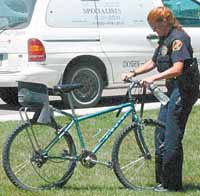| Police Officer Susan Hyde checks the handlebars of a bicycle recently involved in a minor traffic accident in Price. No one incurred major injuries in the local mishap, but auto-bike crashes claim numerous lives annually. |
Many Carbon County residents are leaving the air-conditioned confines of motor vehicles for different modes of transportation.
Walking or bicycling in the warm summer months is a good form of exercise and also reduces the financial as well as the environmental cost of driving.
But as pedestrians and bicyclists have increased on local streets and sidewalks, so have injury-causing run-ins with motor vehicles.
According to Price Police Capt. Kevin Drolc, collisions between motor vehicles and pedestrians or bicycles are frequently the result of riders or walkers going unseen until it is too late.
Often, drivers don’t check sidewalks when merging into traffic, added the Price City Police Department captain.
“I just don’t think they see bicycles,” commented Drolc. “They’re watching for cars.”
According to the Utah Department of Health, 40 pedestrians will be killed and 1,100 will be involved in crashes with motor vehicles during an average year in the state.
Department statistics indicate that one-half of all injured pedestrians are ages 19 or younger and more than 60 percent are male.
As a state, Utah ranked 20th highest in the nation for pedestrian fatalities from 1993-2002.
There is also a significant lack of public education regarding pedestrian safety rules and laws, pointed out the state health department.
In the United States, less than $1 is spent per person on pedestrian education.
There is also a constant increase in the number of motor vehicles and roads at locations across the nation.
Other attributed causes of pedestrian casualties include:
•An unfriendly pedestrian environment, including narrow sidewalks, walkways located next to high-speed roads, no sidewalks or too few crosswalks.
•Speed – More than 80 percent of pedestrians hit by motor vehicles traveling 40 to 45 miles per hour will die of injuries incurred in the traffic accidents.
One-half of the victims die when they are struck by vehicles traveling 30 mph.
Three percent to 5 percent of pedestrians struck by cars traveling only 20 mph are killed.
•Alcohol use by the driver or pedestrian.
•Inadequate adult supervision of children.
•Overestimating a child’s ability to cross a street safely.
•Teen drivers – Of all pedestrians struck by cars, nearly one-fourth were hit by teenage drivers.
•Pedestrians taking chances by crossing the street in the middle of the block, where there is no crosswalk.
•Pedestrians who enter the roadway from between parked vehicles.
Although cyclists fair much better on Utah’s streets, the state’s bicycle fatality rate is still the 8th highest in the nation.
During the years between 1993 and 2002, 67 fatalities resulted from crashes between bicycles and motor vehicles.
The months of May through September have the highest rates of bicyclist-motor vehicle accidents compared to the rest of the year in Utah.
An average of 2.5 vehicle-bicycle crashes per day are generally reported during June, July and August.
Half the people involved in the traffic crashes are between the ages of 5 and 19.
While it is the responsibility for motor vehicle operators to share the streets and highways with pedestrians and cyclists, the rules of the road still apply to people who are not traveling in automobiles, pointed out Drolc.
It is often assumed that bicyclists and pedestrians always have the right of way.
However, Drolc said that any person on the road, whether on foot, on a bike or in a car, is required to observe all traffic laws, pointed out Drolc.
In the case of a collision, bicyclists or pedestrians who fail to adhere to traffic laws will be cited.
UDOH offers several recommendations for safer bicycling on the road. Carbon County residents should:
•Ride on the right side of the street in the same direction as traffic.
If traveling in a group, people ride single file unless passing other bicyclists.
•Before entering a street from a driveway, curb or sidewalk, bicyclists should always stop to check the roadway for oncoming motor vehicle traffic by looking left, right and then left again.
•Ride predictably in a straight line.
Bicyclists should never swerve from side to side across a street or highway.
•Do not go back and forth between the sidewalk and roadway.
•Before moving left, always look over a shoulder to check for traffic coming from behind.
•Bicyclists should always use hand signals to let the drivers of cars, pickup trucks, commericial vehicles and vans know what their intentions are.
•Never pass a car on the right side.
The driver of the vehicle may be attempting to execute a right-hand turn and may not see a pedestrian or bicycle rider.
•When people plan to ride at night, the bicycles must must be equipped with headlights, red taillights and reflectors.
All bicylces must be visible from a distrance of 500 feet
•Yield to pedestrians when riding on a sidewalk.
•Always wear a helmet.
Many bicycle-motor vehicle crashes are caused by common errors that could be easily avoided.
The Utah Department of Health indicates that the most common errors young bicyclists make include:
•Riding into streets from a driveway, sidewalk or curb without stopping.
•Swerving or moving left into traffic .
•Running stop signs and red lights.
•Riding against the flow of traffic.
If drivers and pedestrians will be more aware and more patient, the roadway will be significantly safer for any method of transportation, concluded Drolc.

